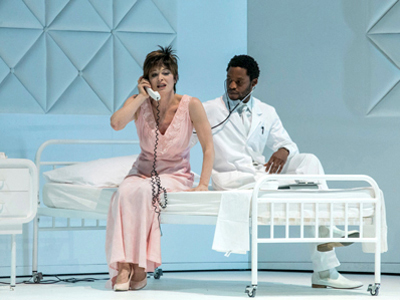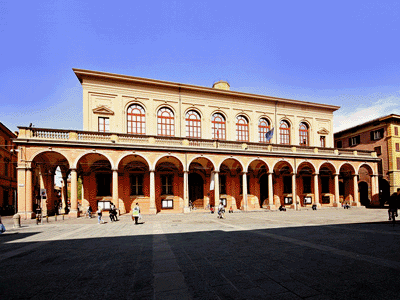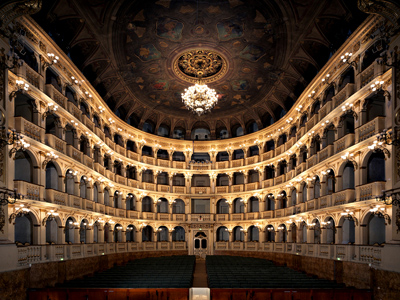
By ANDREW POWELL
Published: April 25, 2017
BOLOGNA — Teatro Comunale’s busy direttore musicale Michele Mariotti, 38, ventured his 33rd and 34th operas* this month with a foray in verismo, the terse tribulations of Cavalleria rusticana, and, incongruously, La voix humaine, a vehicle for the Bologna-schooled soprano, former mezzo, Anna Caterina Antonacci. He chose big voices in Mascagni’s melodramma in un atto (1889) — Carmen Topciu a smooth-toned Santuzza at the April 9 opening, Marco Berti a steely Turiddu, Gezim Myshketa an engaging, richly projected Alfio — and took a broad, detailed view of the score, tracing its melodies grandly and milking its dark sonorities. His orchestra provided luxuriant support, but it was the ardent and incisive singing of Andrea Faidutti’s Coro del Teatro Comunale di Bologna that left the firmest musical impression. Antonacci communicated handsomely through the notes as Elle in Poulenc’s tragédie lyrique en un acte (1958), before the break, without always correctly projecting Cocteau’s vowels. Mariotti proved a restrained collaborator here. None of the musicians were helped by Sicilian stage director Emma Dante, whose unspectacular concepts limited both operas. The Poulenc she placed in a nuthouse, with Elle on an unconnected receiver, thus forcing the elegant Antonacci to enliven not Cocteau’s suspenseful telephone call but what amounted to a 40-minute tantrum. Six mimes, two of them nurses with needles, buoyed the effort. The Mascagni she set against a black background, relying on corny props and costumes to summon vital notions of Sicily while she made points about men’s abuse of women. Crucifixes (a trademark of hers) and sad-sacred imagery suggested her confusion of Easter Day with Good Friday.
“Trovo bellissimi i mimi. Elle ha tentato il suicidio per la disperazione di essere stata abbandonata ed è ricoverata in clinica e da li fa una telefonata virtuale all’ ex-amante. Infatti il telefono non è collegato.” — Angela Schiavina
[*ROSSINI: Il barbiere di Siviglia (2005, Salerno); L’italiana in Algeri (2007, Bologna); La gazza ladra (2009, Bologna); Sigismondo (2010, Pesaro); La Cenerentola (2011, Bologna); Matilde di Shabran (2012, Pesaro); La donna del lago (2013, London); Guillaume Tell (2013, Pesaro); Semiramide (2017, Munich); DONIZETTI: Don Gregorio (2006, Wexford); Don Pasquale (2009, Torino); Lucia di Lammermoor (June 2017, Bologna); PUCCINI: Gianni Schicchi (2006, Fano); ZANINELLI: Snow White (2006, Firenze); VERDI: Simon Boccanegra (2007, Bologna); Nabucco (2008, Reggio Emilia); Rigoletto (2008, Lima); La traviata (2009, Macerata); Il trovatore (2011, Busseto); Un ballo in maschera (2015, Bologna); Attila (2016, Bologna); I due Foscari (2016, Milan); La forza del destino (Sept. 2017, Amsterdam); BELLINI: I puritani (2008, Mahón); Norma (2012, Torino); BIZET: Carmen (2010, Bologna); MOZART: Idomeneo (2010, Bologna); Le nozze di Figaro (2012, Bologna); Così fan tutte (2014, Bologna); Die Zauberflöte (2015, Bologna); DALLAPICCOLA: Il prigioniero (2011, Modena); FERRERO: Risorgimento! (2011, Modena); MASSENET: Werther (2016, Bologna); MEYERBEER: Les Huguenots (2016, Berlin); MASCAGNI: Cavalleria rusticana (2017, Bologna); and POULENC: La voix humaine (2017, Bologna).]
Photo © Rocco Casaluci
Related posts:
Mariotti Cheers Up Bologna
Parsifal the Environmentalist
Winter Discs
Mariotti North of the Alps
Kuhn Paces Bach Oratorio


Guillaume Tells
Wednesday, September 23rd, 2015By ANDREW POWELL
Published: September 23, 2015
MUNICH — Post is under revision.
Still image from video © Bayerische Staatsoper
Related posts:
Nitrates In the Canapés
Muti the Publisher
Honeck Honors Strauss
Kušej Saps Verdi’s Forza
Time for Schwetzingen
Tags:Amanda Forsythe, Andrew Foster-Williams, Antonino Fogliani, Antonio Pappano, Antú Romero Nunes, Bad Wildbad, Bavarian State Opera, Bayerische Staatsoper, Bongiovanni, Bryan Hymel, Camerata Bach Chor Poznań, CD, Commentary, Coro del Teatro Comunale di Bologna, Damiano Michieletto, Dan Ettinger, Decca, DVD, Evgeniya Sotnikova, Gerald Finley, Graham Vick, Guillaume Tell, Günther Groissböck, Jochen Schönleber, John Osborn, Juan Diego Flórez, Judith Howarth, Kritik, Luca Tittoto, Malin Byström, Marina Rebeka, Michael Spyres, Michael Volle, Michele Mariotti, München, Münchner Opernfestspiele, Munich, Munich Opera Festival, National Theater, Nationaltheater, Naxos, Nicola Alaimo, Nicolas Courjal, Opus Arte, Orchestra del Teatro Comunale di Bologna, Pesaro, Raffaele Facciolà, Review, Rossini, Rossini Opera Festival, Royal Opera House, Sofia Fomina, Tara Stafford, Virtuosi Brunenses
Posted in Munich Times | Comments Closed